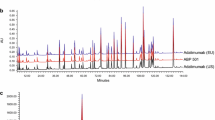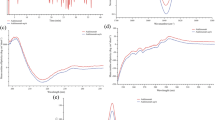Abstract
Biosimilars are highly complex and similar biological drugs are developed with different manufacturing processes which are not similar to originator manufacturing process. Due to this, biosimilar products inherently have quality differences in comparison to innovator molecule which may be related to size, charge and glycosylation. Despite these differences they are supposed to demonstrate similar behaviour in safety and efficacy profile to the reference product and these differences should not be clinically meaningful. Charge variants are one of the critical quality attributes and sources of heterogeneity. In this study, highly purified charge variants cluster (acidic, main peak and basic) of biosimilar product of Xolair were assessed for their impact on in vitro potency and stability at different thermal stress conditions (2–8 °C and − 20 °C). The study data indicating purified charge variants (> 90%) have no impact on in vitro potency and are stable at different thermal stress conditions up to a week.
Graphical abstract



Similar content being viewed by others
Data availability
Not applicable.
References
Xiao Z, Yin X, Han L, Sun B, Shen Z, Liu W, Yu F (2018) Comprehensive approach for evaluating charge heterogeneity in biosimilars. Eur J Pharm Sci 115:19–24. https://doi.org/10.1016/j.ejps.2018.01.016
FDA Guidance for Industry. Scientific considerations in demonstrating biosimilarity to a reference product (2015). https://www.fda.gov/regulatory-information/search-fda-guidance-documents/scientific-considerations-demonstrating-biosimilarity-reference-product. Accessed Apr 2015
EMA Guideline on similar biological medicinal products (2014). http://www.ema.europa.eu/docs/en_GB/document_library/Scientific_guideline/2014/10/WC500176768.pdf. Accessed Oct 2014
Yamaguchi T, Arato T (2011) Quality, safety and efficacy of follow-on biologics in Japan. Biologicals 39:328–332. https://doi.org/10.1016/j.biologicals.2011.06.015
Declerck P, Danesi R, Petersel D, Jacobs I (2017) The language of biosimilars: clarification, definitions, and regulatory aspects. Drugs 77:671–677. https://doi.org/10.1007/s40265-017-0717-1
Ishii-Watabe A, Kuwabara T (2019) Biosimilarity assessment of biosimilar therapeutic monoclonal antibodies. Drug Metab Pharmacokinet 34:64–70. https://doi.org/10.1016/j.dmpk.2018.11.004
Hintersteiner B, Lingg N, Janzek E, Mutschlechner O, Loibner H, Jungbauer A (2016) Microheterogeneity of therapeutic monoclonal antibodies is governed by changes in the surface charge of the protein. Biotechnol J 11:1617–1627. https://doi.org/10.1002/biot.201600504
Farjami A, Siahi-Shadbad M, Akbarzadehlaleh P, Roshanzamir K, Molavi O (2019) Evaluation of the physicochemical and biological stability of cetuximab under various stress condition. J Pharm Pharm Sci 22:171–190. https://doi.org/10.18433/jpps30427
Yanchao W, Chen Z, Chao Z, Qiang F, Baohong Z, Yanling B, Nianmin Q, Jianwei Z (2022) Characterization and pre-clinical assessment of a proposed biosimilar to its originator Omalizumab. Eur J Pharm Sci 178:0928–0987. https://doi.org/10.1016/j.ejps.2022.106292
Putnam WS, Prabhu S, Zheng Y, Subramanyam M, Wang YMC (2010) Pharmacokinetic, pharmacodynamic and immunogenicity comparability assessment strategies for monoclonal antibodies. Trends Biotechnol 28:509–516. https://doi.org/10.1016/j.tibtech.2010.07.001
Khawli LA, Mizokami MM, Sharifi J, Hu P, Epstein AL (2002) Pharmacokinetic characteristics and biodistribution of radioiodinated chimeric TNT-1, -2 and -3 antibodies modified with biotin. Cancer Biother Radiopharm 17:359–370. https://doi.org/10.1089/108497802760363150
Wang W (1999) Instability, stabilization, and formulation of liquid protein pharmaceuticals. Int J Pharm 185:129–188. https://doi.org/10.1016/s0378-5173(99)00152-0
Paul M, Vieillard V, Jaccoulet E, Astier A (2012) Long-term stability of diluted solutions of the monoclonal antibody rituximab. Int J Pharm 436:282–290. https://doi.org/10.1016/j.ijpharm.2012.06.063
Le Basle Y, Chennell P, Tokhadze N, Astier A, Sautou V (2020) Physicochemical stability of monoclonal antibodies: a review. J Pharm Sci 109:169–190. https://doi.org/10.1016/j.xphs.2019.08.009
Zhao YY, Wang N, Liu WH, Tao WJ, Liu LL, Shen ZD (2016) Charge variants of an avastin biosimilar isolation, characterization, in vitro properties and pharmacokinetics in rat. PLoS ONE 17:e0151874. https://doi.org/10.1371/journal.pone.0151874
Gupta T, Seshadri S (2023) Charge variants of proposed biosimilar to Omalizumab: Isolation, purification and analysis by HPLC methods. Ann Pharm Fr (Accepted manuscript). https://doi.org/10.1016/j.pharma.2023.09.003
Gupta T, Kumar A, Seshadri S (2023) Bioprocess challenges in purification of therapeutic protein charge variants. Biotechnol Bioprocess Eng (Accepted manuscript). https://doi.org/10.1007/s12257-023-0078-4
Acknowledgements
The authors are grateful to Kashiv BioSciences Pvt. Ltd. for support with the necessary facilities and guidance for the completion of the research article.
Funding
Not applicable.
Author information
Authors and Affiliations
Contributions
Tarun Gupta and Sriram Seshadri performed the literature search. Tarun Gupta contributed to research work related to experiments and data compilation. Sriram Seshadri designed and supervised the research work.
Corresponding author
Ethics declarations
Conflict of interest
The authors declare that they have no conflict of interest.
Ethical approval
Not applicable.
Consent to participate
Not applicable.
Consent to publish
Not applicable.
Additional information
Publisher's Note
Springer Nature remains neutral with regard to jurisdictional claims in published maps and institutional affiliations.
Rights and permissions
Springer Nature or its licensor (e.g. a society or other partner) holds exclusive rights to this article under a publishing agreement with the author(s) or other rightsholder(s); author self-archiving of the accepted manuscript version of this article is solely governed by the terms of such publishing agreement and applicable law.
About this article
Cite this article
Gupta, T., Seshadri, S. Highly purified charge variants of a proposed biosimilar to Omalizumab: impact on in vitro potency and stability under thermal stress. Bioprocess Biosyst Eng 47, 57–64 (2024). https://doi.org/10.1007/s00449-023-02944-8
Received:
Accepted:
Published:
Issue Date:
DOI: https://doi.org/10.1007/s00449-023-02944-8




